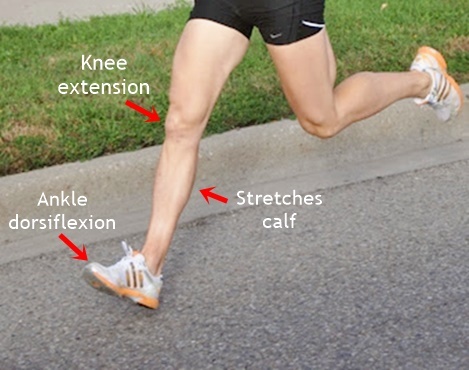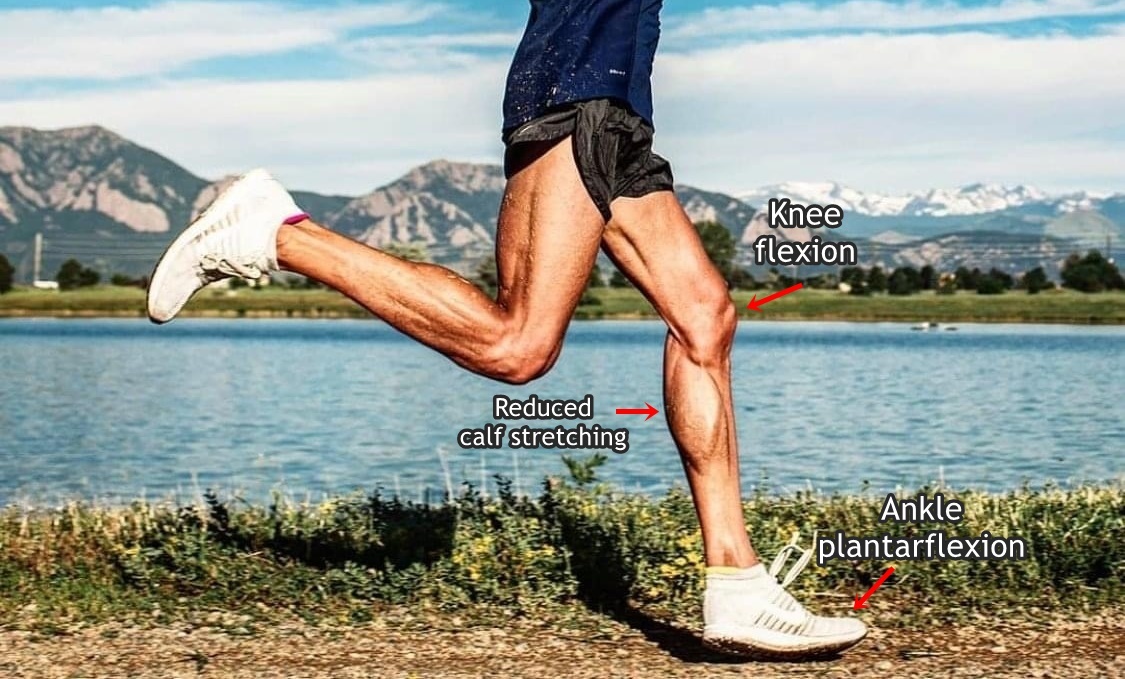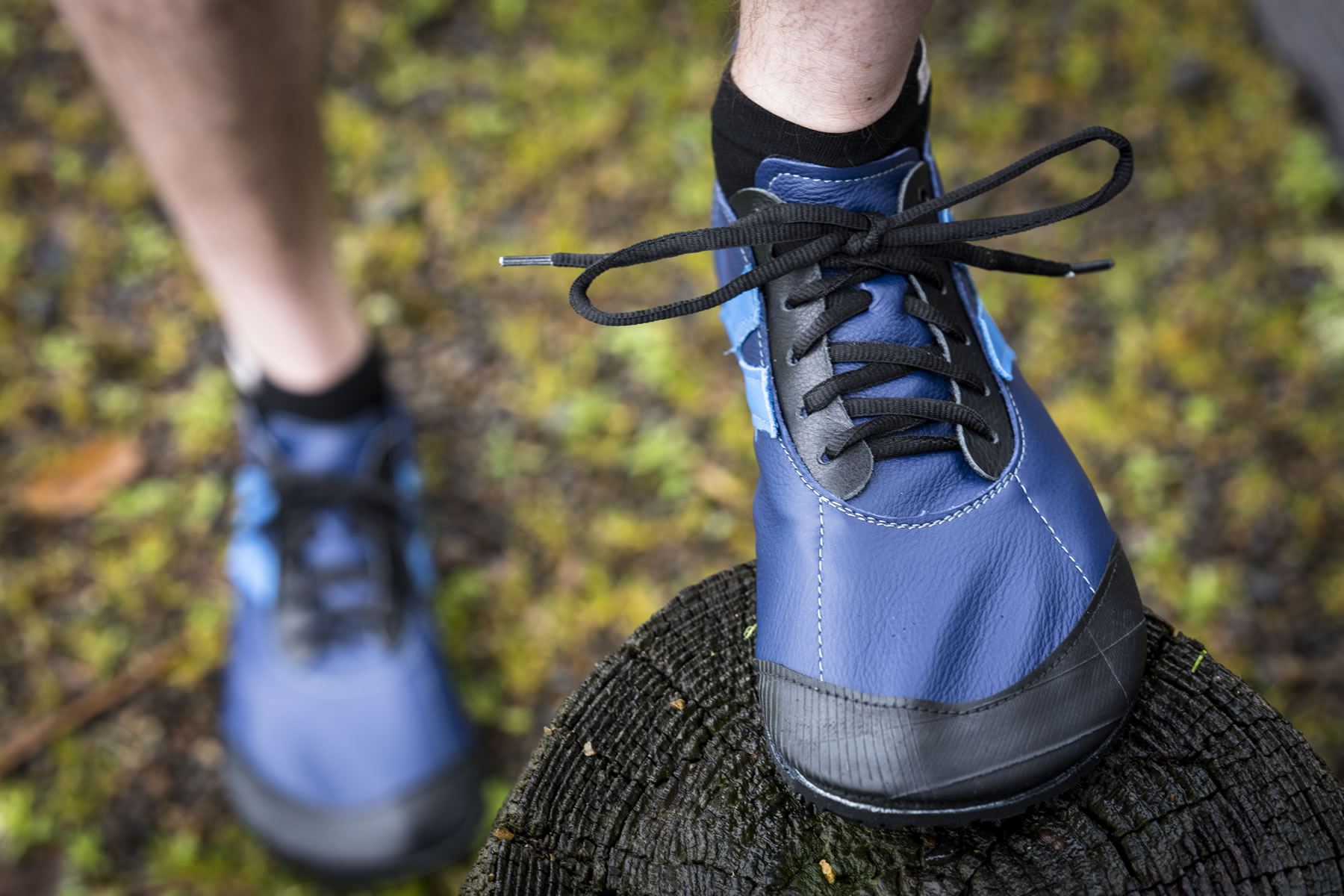Heel strike running increases the risk of calf pain and injury because the mechanical patterns often accompanied with landing heel-first during running causes the calf musculature to excessively stretch at touchdown. As a result, the calves get overused and impact gets amplified.
A study in the American Journal of Sports Medicine as well as a study in the journal Gait and Posture concluded that increased ankle dorsiflexion (front of the foot points up) coupled with knee extension (unbent knee) at heel strike during running (shown below) forcibly stretched the medial calf muscle of which the muscle could no longer contribute to impact absorption efficiently.
- When a muscle is intensively stretched, it automatically becomes strained because it develops tension while lengthening, which compromises its capacity to absorb impact.
A consequence of this scenario is the calves are under a lot of strain from being over-stretched which produces a rise in impact which not only is more stressful on the calves, but the knees and hips as well.


This is how heel strike running is a significant contributor to persistent calf pain and injury as compared with forefoot running which enables the calf muscles to be used more effectively as impact absorbers. This is because landing forefoot-first while running naturally engages a plantarflexed ankle (forefoot points down) and a slightly bent knee (knee flexion) upon and at touchdown (shown below) of which the calf muscle does not undergo rapid stretching and is more relaxed.

This is yet another example of how forefoot running provides better impact reduction by improving the natural ability of the calves to function as shock absorbers, and is why forefoot running gives you better results in reducing the risk of impact-related injury.
If you’ve enjoyed this content, you’ll love my YouTube channel here, where I speak more on the evidence-based advantages of forefoot running over heel strike running.
References:
DEVITA , P., and J. STRIBLING . Lower extremity joint kinematics and energetics during backward running. Med. Sci. Sports Exerc. 23: 602–610, 1991.
Ishikawa M., Pakaslahti J and Komi PV. Medial gastrocnemius muscle behavior during running and walking. Gait & Posture, 2007; 25:380-84.
Lieberman DE, Venkadesan M, Werbel WA, et al. Foot strike patterns and collision forces in habitually barefoot versus shod runners. Nature. 2010;463:531-535.
Miller WA. Rupture of the musculotendinous juncture of the medial head of the gastrocnemius muscle. Am J Sports Med. 1977;5:191-193.
MORTON , C. Running backward may help athletes move forward. Phys. Sportsmed. 14:149–152, 1986.
If you’d like, you can support Run Forefoot by shopping for minimalist footwear from the following places:
Be Lenka: https://www.dpbolvw.net/click-7600968-14330828
Wilding Shoes: https://bit.ly/3lIygQP
Xero Shoes: http://bit.ly/2UIR9YK
Zappos: https://bit.ly/3agv5NG
Vivobarefoot: https://amzn.to/3wPRKIk
You can also show support and help keep Run Forefoot going by making a donation in any amount of your choosing: https://www.paypal.me/RunForefoot

If you’ve enjoyed this article, you’ll love my content over at my YouTube channel, here, where I go into more detail about the evidenced-based facts on the performance and injury preventative advantages of forefoot running vs heel strike running.
Bretta Riches
BSc Neurobiology; MSc Biomechanics candidate, ultra minimalist runner & founder of RunForefoot. I was a heel striker, always injured. I was inspired by the great Tirunesh Dibaba to try forefoot running. Now, I'm injury free. This is why I launched Run Forefoot, to advocate the health & performance benefits of forefoot running and to raise awareness on the dangers of heel striking, because the world needs to know.
Latest posts by Bretta Riches (see all)
- Can You Run In Barefoot Shoes? Yes, But DON’T Heel Strike! - 21/07/2024
- Why Cushioned Running Shoes Are Really Bad for Your Feet - 19/07/2024
- Do Cushioned Running Shoes Cause Injuries? - 17/07/2024
